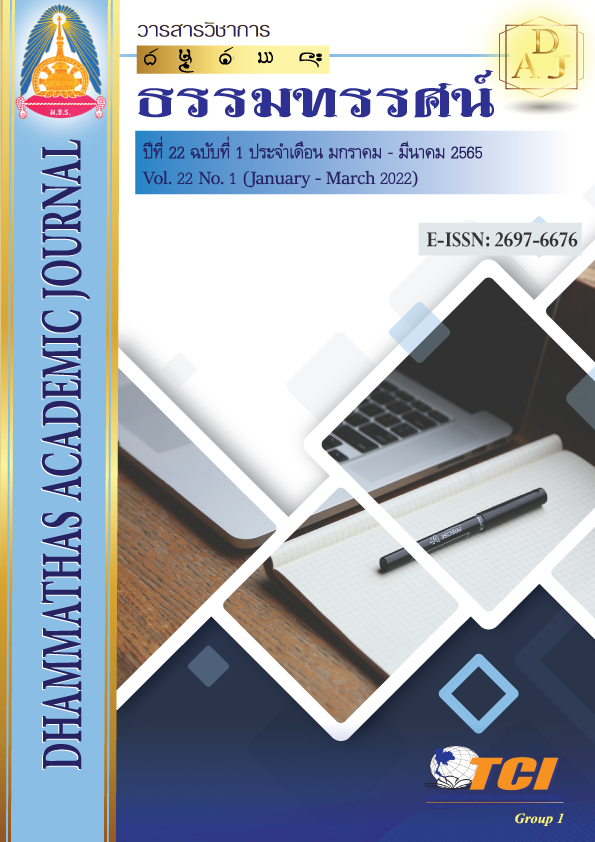Management of Wat Phra That Nong Sam Muen Historic Site of Chaiyaphum Province
Main Article Content
Abstract
The objectives of this research were; 1) to investigate management practices of Wat Phra That Nong Sam Muen; 2) to study the conditions of problems and rules of the management of Wat Phra That Nong Sam Muen; 3) to study the factors affecting management practices of Wat Phra That Nong Sam Muen. A qualitative research was this study method. The instruments used to collect data was in-depth interviewed. Data were collected from 32 cases includes, cardinal, local scholars, community and local leader, and village sages. Content analysis and data presentation by description method.
The results are as follows:
1. Management of Wat Phra That Nong Sam Muen Nowadays, the Sangha administrators have developed technology. Integrate with Buddhist principles leading to administration/government along with prosperity and law. Laws, regulations, and various rules come to support the Dharma and Discipline, especially the administration/government of the temple, which has a very different form from the past, such as planning, organizing, personnel management, coordinating, reporting and budgeting have a format that practice more clearly, organizing the management by emphasizing on personnel work, administrative tasks, budgets, organizational work focusing on clear, transparent management, compliance with various regulations
2. Management problems such as historical site that exist in the temple are not thoroughly maintained. A few technology and tools for public relations. The lack of strong community integration results in the relationship between the temple and the community becoming more distant.
3. Factors affecting the managementwere building cooperation with all sectors by establishing a group of local scholars or a young guide to convey the historical stories of tourist attractions and supplementing with green tourism, creating participation of local people in the conservation and development of ancient monuments and provide public relations in various forms.
Article Details

This work is licensed under a Creative Commons Attribution-NonCommercial-NoDerivatives 4.0 International License.
เพื่อให้เป็นไปตามกฎหมายลิขสิทธิ์ ผู้นิพนธ์ทุกท่านต้องลงลายมือชื่อในแบบฟอร์มใบมอบลิขสิทธิ์บทความ ให้แก่วารสารฯ พร้อมกับบทความต้นฉบับที่ได้แก้ไขครั้งสุดท้าย นอกจากนี้ ผู้นิพนธ์ทุกท่านต้องยืนยันว่าบทความ ต้นฉบับที่ส่งมาตีพิมพ์นั้น ได้ส่งมาตีพิมพ์เฉพาะในวารสาร วิชาการธรรม ทรรศน์ เพียงแห่งเดียวเท่านั้น หากมีการใช้ ภาพหรือตารางของผู้นิพนธ์อื่นที่ปรากฏในสิ่งตีพิมพ์อื่นมาแล้ว ผู้นิพนธ์ต้องขออนุญาตเจ้าของลิขสิทธิ์ก่อน พร้อมทั้ง แสดงหนังสือที่ได้รับการยินยอมต่อบรรณาธิการ ก่อนที่บทความจะได้รับการตีพิมพ์References
กรมการศาสนา กระทรวงวัฒนธรรม. (2552). จริยธรรมสำหรับเด็กและเยาวชน. กรุงเทพฯ:กรมการศาสนา กระทรวงวัฒนธรรม.
ธรรมศักดิ์ โรจนสุนทร. (2542). สรุปผลการสัมมนาการพัฒนาการท่องเที่ยวภาคเหนือ.กรุงเทพฯ: การท่องเที่ยวแห่งประเทศไทย.
บุญพิเชษฐ์ จันทร์เมือง. (2553). การจัดการการท่องเที่ยวในพระอารามหลวงชั้นเอก ในเกาะรัตนโกสินทร์. (วิทยานิพนธ์วิทยาศาสตรมหาบัณฑิต). กรุงเทพฯ: มหาวิทยาลัยศรีนครินทรวิโรฒ.
ประภัสสร์ ชูวิเชียร. (2550). 5 มหาเจดีย์สยาม. กรุงเทพฯ: มิวเซียมเพรส.
พระราชบัญญัติคณะสงฆ์ พ.ศ. 2505. (2505, 31 ธันวาคม). ราชกิจจานุเบกษา. เล่มที่ 79 ตอนที่ 115, หน้า 6.
พระสมุห์อนุรักษ์ ธีรสกฺโก. (2554). การพัฒนาวัดเพื่อการท่องเที่ยวเชิงพุทธในจังหวัดสมุทรสาคร. (วิทยานิพนธ์พุทธศาสตรมหาบัณฑิต). กรุงเทพฯ: มหาวิทยาลัยมหาจุฬาลงกรณ์ราชวิทยาลัย.
พระครูวรเจติยาภิรักษ์ (นิรันดร์). (2554). การศึกษาความเชื่อและพิธีกรรมของชาวบ้านแก้งที่มีต่อพระธาตุหนองสามหมื่น ตำบลบ้านแก้ง อำเภอภูเขียว จังหวัดชัยภูมิ. (วิทยานิพนธ์พุทธศาสตรมหาบัณฑิต). กรุงเทพฯ: มหาวิทยาลัยมหาจุฬาลงกรณราชวิทยาลัย.
วิวัฒน์ชัย บุญภักดิ์. (2532). ท้องถิ่นจะช่วยการท่องเที่ยวได้อย่างไร. จุลสารการท่องเที่ยว, 6 (2), 13.
อาทิตยา เครือจันทร์ และศรีสุพร ปิยรัตนวงศ์. (2559). แนวทางพัฒนาแหล่งท่องเที่ยวเชิงประวัติศาสตร์: กรณีศึกษาแหล่งโบราณสถานโมคลาน จังหวัดนครศรีธรรมราช.วารสารสงขลานครินทร์, 22(2), 31-52.
Creswell, J. W., & Garrett, A. L. (2008). The “Movement” of Mixed Methods Research and the Role of Educators. South African Journal of Education, 28, 321-333.

